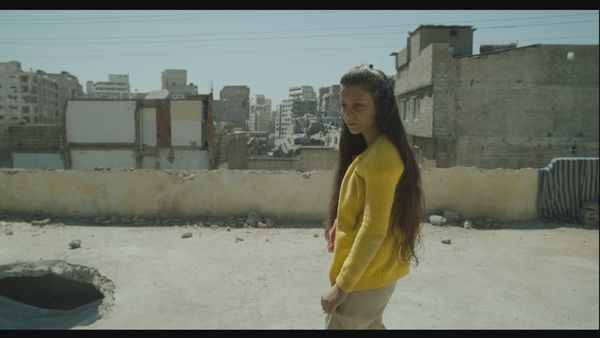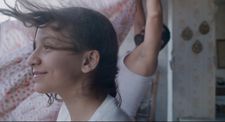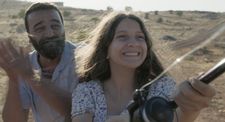 |
| Nezouh Photo: Nezouh Ltd, BFI & Film4 |
In director Soudade Kaadan's magical realist Nezouh, photographed by the French cinematographer Hélène Louvart (The Invisible Life Of Euridice Gusmao, Never Rarely Sometimes Always, Happy As Lazzaro, The Lost Daughter, La Chimera), 14-year-old Zeina (Hala Zein) and her family are the only ones remaining in their besieged hometown of Damascus, Syria.
When a missile damages their home, a rope is mysteriously lowered through the hole in the roof, offering Zeina an escape from the confines of her apartment. Zeina's father Mutaz (Samir Almasri) refuses to leave, fearful of life as a refugee. As the conflict continues to rage, Zeina and Hala (Kinda Alloush), her mother, must decide whether to go against Mutaz's wishes and leave Damascus.
 |
| Nezouh Photo: Nezouh Ltd, BFI & Film4 |
Speaking with Eye For Film, Louvart discussed the director and cinematographer's relationship, and balancing Nezouh's different points of view.
Paul Risker: Looking back on your body of work, how has your method evolved from film to film?
Hélène Louvart: The most important thing for me is to choose a film and to make it according to the story. Then, it's about knowing how the director wants to shoot it. When you want to tell a story, I will not say you should only get one point of view, but it's important to try to get a point of view of the person who is telling the story, and I'd say it's the director.
My job is to help this person tell the story visually as well as possible. It could be with colour, it could be dark, it could be bright, it could be moving or still, whatever. I don't have any concerns, but it has to be linked with the story. And because I work with different directors, I, of course, try to bring something different because they aren't the same. Someone might not like too much movement all of the time and somebody else will say, “I don't like to be fixed, I like to be moving.” Who is wrong? Who is right? We don't know. It's a way to look and to think, and my job is to be here at this moment.
PR: We can be obsessive about what we like, but that doesn’t necessarily mean we understand why - it might be instinctive. Does this complicate helping the director to tell the story?
HL: No, it's not difficult. You have to follow and understand the script and to work scene-by-scene. For me, it's a way to understand what the director wants to do and when you share films, asking why they like or don’t like a film. Is it the story, the way it's shot or because it touched you in a deeper way? It's very important to understand why a director likes or hates a film. If he or she hates it, then perhaps we should go in a different direction. After, I have to translate [this knowledge] with the light, with the way of shooting and to bring the director into this decision and to try to make something personal.
 |
| Nezouh Photo: Nezouh Ltd, BFI & Film4 |
PR: What initially interested you about working with Soudade on Nezouh?
HL: I knew Soudade when she was prepping her first feature film [The Day I Lost My Shadow]. We met and there was a change that meant I was no longer available, and so, when she was going to do Nezouh, we wanted to work together.
She's not afraid of a challenge and it’s a challenging script. It's not just people talking, you have to create the world that she knows and lift reality. She didn't want to make a documentary. It's through the gaze of the girl, but it's also a magic world and there’s something poetic.
[…] It was very challenging because we didn't want to make something kitsch because it would not be good for the story. We have to believe in the story – it’s not funny but a dramatic situation, and at the same time, it's not a documentary.
Soudade knows exactly what she wants to see, and it was great to work with her to prep it and then try to do it, and to not be afraid. Sometimes it was complicated, but we said we'd try to do what we can, and it was full of hope. Soudade is great when she has a challenge like this.
PR: How did you construct the visual language around the idea of being inside the girl's gaze?
HL: I think we mixed the point of view of the storytelling, between Soudade’s and the little girls. But we didn't want it to be too obvious by using a handheld camera. We used a tracking rail and a steadicam. It was very precise, and sometimes we’d go out of the building through the window and look at the characters. We don't need the point of view of a character all the time, instead, we can pan - it's the point of view of the film.
At the same time, we didn’t want to be too over the top, otherwise we'd lose the story, and so we tried to be subtle. In an apartment, you usually have a ceiling, a small window, but suddenly there's no window, it's totally open and there’s a hole in the ceiling. So, it was great to shoot in the apartment because it was open - it was a dream.
Nezouh is in UK & Irish cinemas now.





















